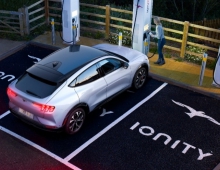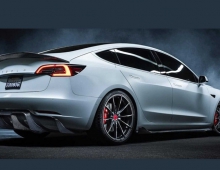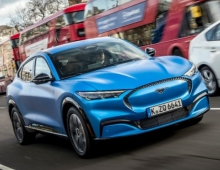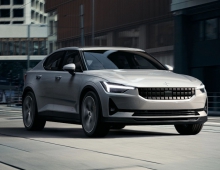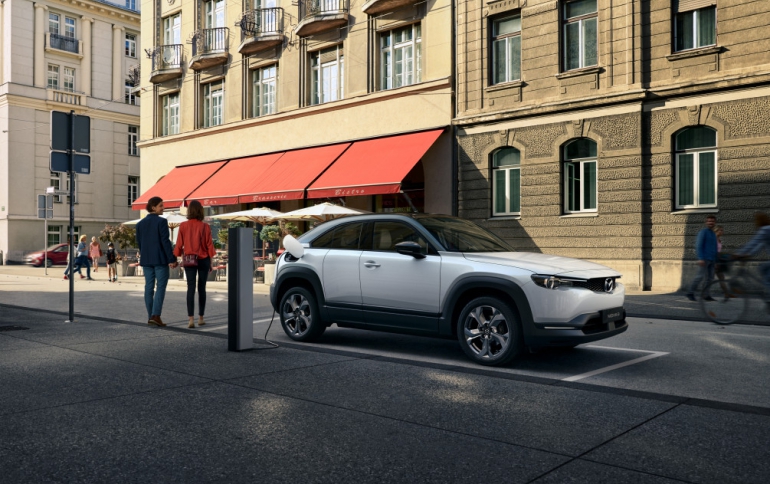
Mazda MX-30 EV Debuts at the Tokyo Motor Show 2019
Mazda Motor Corporation has unveiled its first mass-production electric vehicle, named Mazda MX-30, at the 2019 Tokyo Motor Show.
The MX-30 is the automaker's third new-generation model. It adopts freestyle doors so owners can invent new ways of using the car. Spaces in and around the center console give the cabin an open feel, and environmentally conscious materials such as cork and fabrics made from recycled materials are used in ways that bring out their natural appeal.
One of the most interesting features of the MX-30 is its center-pillar-less Freestyle doors with custom-designed hinges that allow the front doors to open to 82° and rear doors to open to 80°. This not only makes entering and exiting the car and loading and unloading cargo easier but also provides easier access for strollers and wheelchairs. The wide angle to which the front doors open was designed to facilitate this wide variety of usage styles. For example, the layout and the absence of a center pillar make it possible to bring a stroller right up beside the rear seat and comfortably put a baby into a child seat while maintaining eye contact. The front door is opened first, followed by the rear door, and both can be opened without changing position.
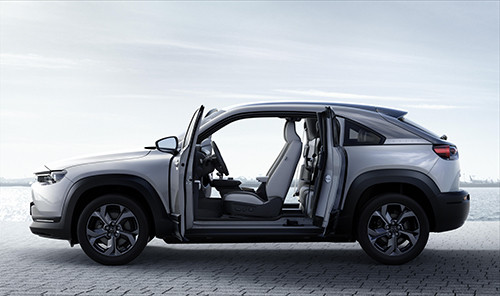
The rear door trim adopts a vertical grip that makes opening and closing the door easier and that does not place much burden on the wrist when reaching for it, even with the door wide open. The front seats are equipped with a walk-in mechanism that, with a single touch, folds the seatback forward and simultaneously slides the whole seat toward the front.
For the MX-30, while retaining the handcrafted forms of Mazda design, the design team made a simple exterior. The front face bears a friendly expression, and the cabin design, with its framed top and freestyle doors, embodies an image of lightness. D-pillars sweep down at a sharp angle to blend the roof and cabin with the solid mass at the rear. The surfaces that appear flat along the body sides are in fact formed with a curve in them that continues from the front end to the shoulder highlights.
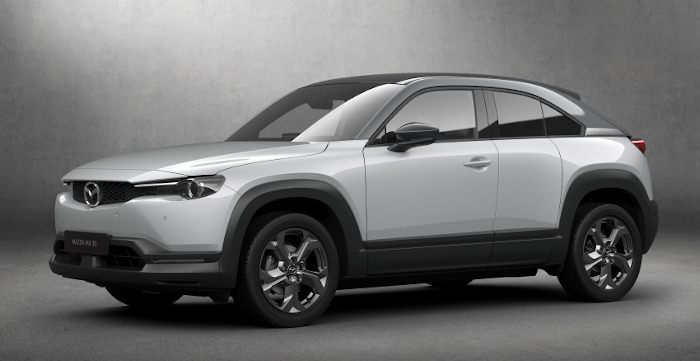
The interior features a floating console and unique materials designed to minimize environmental impact. Heritage Cork used in the console tray is designed to emphasize the texture and visual warmth of the material. The door trim features a fibrous material with a texture that seems to contain air. The door trim uses fibers made from recycled plastic bottles and the cork is harvested from the bark of trees without felling.
A touch panel heater control is adopted for the first time in a Mazda car. This 7-inch touch panel also welcomes drivers getting into the car with a graphic that changes along with the external environment.
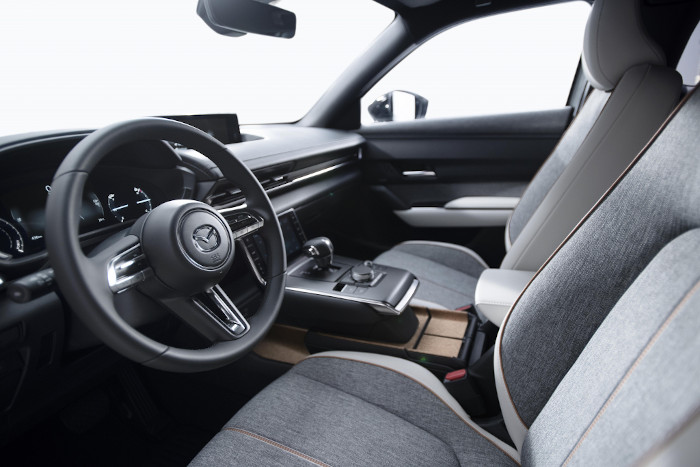
When the driver opens the door and gets into the car, a subtly changing graphic appears on the screen. The graphic changes look depending on the time of day and the temperature outside and helps get the driver in the mood for driving. Once the car is switched on, it displays the air-conditioning controls and lets the driver know that the car is ready to go.
Temperature, airflow and seat heater adjustments can all be controlled via the touchscreen. Push switches mounted on the display’s bezel offer alternative control over A/C on-off, auto control, temperature adjustment, fan speed and window demisting. These switches help ensure proper operation, even when wearing gloves.
The MX-30 furthers the philosophy of the horizontal layout to give the interior a wider look. One change implemented is the introduction of a touchscreen air-conditioning control panel. In addition, the floating floor console, upper section of the instrument panel, meter hood and related trim are designed to create a sense of continuity and lightness.
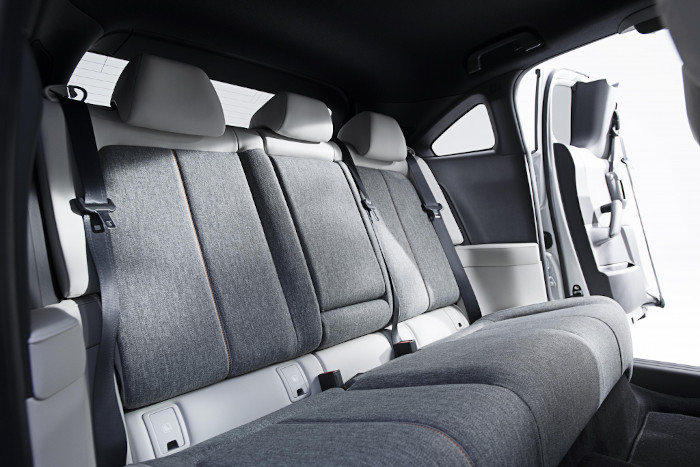
The car takes advantage of its Freestyle doors by using the side door trim for the rear seats to create a design that resembles a couch.
With the MX-30, the company introduces a new electric drive technology called e–Skyactiv. To enhance the consistency of omnidirectional vehicle response to control inputs and realize seamless transitions between G forces, electric G-Vectoring Control Plus (e-GVC Plus) is also equipped. Natural feedback is afforded by precise torque control and sound that lets the driver know exactly what the car is doing.
The MX-30 also strengthens the i-Activsense safety technology suite with new functionality added to Smart Brake Support aimed at helping to prevent collisions at intersections and technology designed to help keep drivers on track on roads with curbs or discernable edges, even in the absence of lane markings. Mazda’s engineers incorporated the latest technologies and development concepts, including a structure to protect the high-voltage battery.
The MX-30 adopts electronic gear shifting. The car uses the same stationary design as the company’s conventional AT shifters. That means the lever locks into each of the P-R-N-D positions, making it easier to determine what gear the vehicle is in at any given time. The shift pattern puts D (Drive) at the back, R (Reverse) at the front and P (Park) offset to the side at the front.
The luggage area is large enough to accommodate four (115cm) carry-on suitcases. There is also a sub-trunk beneath the floor that is convenient for storing small items.
A pair of 2.5A USB ports and a 12V DC power socket are mounted on the front of the floor console as standard equipment. These power outlets make it easy to charge a smartphone, tablet or some other device. The model also includes a 150W AC outlet making it possible to charge devices with larger batteries, such as notebook computers, e-mobility and drones.
Mazda developed new e-Skyactiv electric-drive technology to realize an EV that runs purely on electric power. The high-voltage components that comprise the e-Skyactiv system include the motor, battery pack, inverter, and DC-DC converter. The direct current from the battery is converted to alternating current by the inverter to drive the motor, while the DC-DC converter steps down the voltage to supply power to the car’s various 12V auxiliary equipment.
The motor, inverter, DC-DC converter and junction box are integrated into a single high-voltage unit that is mounted toward the front of the car. The size of the high-voltage battery mounted beneath the floor was chosen to minimize CO2 emissions throughout its life cycle, from resource extraction through to battery disposal. To limit the height of the battery pack, it uses a high-density battery module and thin busbar wiring as part of a scheme that minimizes the size of wiring between high-voltage parts, as well as a thin cooling system. As an additional measure, the battery case is joined to the body to effectively help increase overall rigidity. The normal and rapid charging ports are packaged as a set that is accessed from the right rear fender, with the onboard AC charger positioned in the luggage area.
Another feature is a control scheme that minimizes energy loss throughout the system, including loss from the inverter, the motor and in converting battery power into drive power. This combines with harmonious control between the system and the vehicle that reduces power consumption to maximize the amount of energy that goes directly toward powering the MX-30.
The e-Skyactiv system can be charged using AC power or rapid-charged using DC power. The model supports DC charging with either the CHAdeMO or COMBO standard. Adopting the most appropriate standard for a specific region makes it possible to charge the MX-30 at any charging station in the world. AC charging of up to 6.6kW is also supported.
In the MX-30, Mazda’s G-Vectoring Control (GVC), which uses the powertrain to improve chassis performance, has evolved into e-GVC Plus, which leverages the torque characteristics of the electric motor to optimize the front-rear load shift under an even wider range of usage scenarios. In every speed range, the system achieves seamless transitions between longitudinal and latitudinal G-forces, whether the driver is making steering corrections on a straight roads or cornering.
e-GVC Plus provides fine control over motor torque in response to the driver’s steering wheel operations. When the driver turns the steering wheel to enter a corner, the system reduces torque slightly to instigate load transfer to the front and assume a smooth turning posture. When the driver starts to return the steering wheel to its original (neutral) position as the car begins to exit the corner, torque is increased slightly to shift the load to the rear and stabilize vehicle behavior. This also helps assist in quickly returning to straight-line travel. If the driver quickly returns the steering wheel to the neutral position, brake moment control that settles cornering behavior operates in cooperation.
The motor pedal for e-Skyactiv uses Mazda’s own electric motor torque control system to realize the desired vehicle speed and posture control based on the driver’s intended amount of acceleration or deceleration. It connects forward and reverse torque and supports smooth fore-aft G-force control. Closely monitoring the stroke as well as the speed of the driver’s pedal action enables the pedal to meet the expectations of the driver in responding with linear application of G force. Gradual torque transition makes it easy to maintain vehicle speed when the driver operates the pedal slowly. In contrast, it interprets quick pedal operation as an indication that the driver wishes to accelerate and responds quickly by providing powerful acceleration.
The MX-30 further evolves i-Activsense. One such evolution to the injury- and damage-mitigating brake system adds Turn-Across Traffic functionality to the existing Smart Brake Support (SBS) system to help prevent collisions when turning across traffic at intersections. The MX-30 also introduces new technologies, including Road Keep Assist, which helps keep the car on the right track even in the absence of lane markings and Emergency Lane Keeping with Blind Spot Assist, which helps prevent collisions when changing lanes. On the passive safety front, despite the MX-30 adopting Mazda’s center-pillar-less Freestyle door system, rigid body and structures that efficiently absorb crash energy achieve a high level of collision safety performance.
SBS adds a new Turn-Across Traffic function to the vehicle, pedestrian, nighttime pedestrian and bicycle monitoring functions already built into the system. When turning left at an intersection, (on left-hand drive units), the forward-sensing camera and milliwave radar sensors monitor oncoming traffic. When the system determines there to be a chance of a collision occurring, it automatically applies the brakes to help prevent impact or mitigate damage that may occur. The function only operates at low speeds and is programmed to monitor nearby vehicles.
When travelling at speeds of approximately 60km/h or greater, the forward-sensing camera monitors grass, curbs and such along the edges of unmarked roads. When the system determines there to be a chance of the vehicle drifting off the road, it assists steering operations to prevent that from happening. This helps instill greater peace of mind when driving on roads without lane markings.
The system uses 24GHz milliwave radar sensors to monitor the areas behind and to the sides of the car when travelling at speeds of 60km/h or greater. If the driver steers to change lanes when there is a threat of colliding with a vehicle approaching from the rear, the system assists steering operations to help prevent impact or mitigate damage that may occur.


